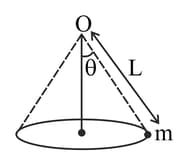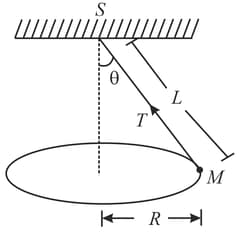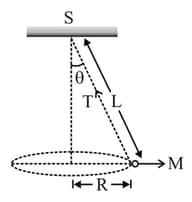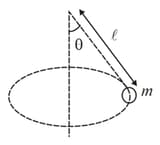Motion in a Horizontal Circular Track
Motion in a Horizontal Circular Track: Overview
This Topic covers sub-topics such as Conical Pendulum, Friction in Circular Motion, Friction and Circular Motion and, Maximum Velocity in Horizontal Circular Track
Important Questions on Motion in a Horizontal Circular Track
The minimum velocity (in ) with which a car driver must traverse a flat curve of radius and coefficient of friction to avoid skidding is,
The time period of a conical pendulum is . The tension in the string is, in the usual notation,
A particle describes a horizontal circle with uniform speed on the smooth surface of an inverted cone. The height of the horizontal plane above the vertex of the cone is . What is the speed of the particle if ?
A pendulum consisting of mass less string of length and a bob of mass is set up as conical pendulum. Its bob now performs . Calculate the KE and increase in gravitational P.E.
While taking turn on a curved road, a cyclist has to bend through a certain angle. This is done
The time period of conical pendulum is given by
A conical pendulum of length makes an angle with the vertical as shown in the figure. The time period will be

A string of length is fixed at one end and carries a mass

Why banking is necessary for circular road?
A car of mass rounds a curve of radius at . Calculate the frictional force required?
A spherical bob hangs from a light inextensible string and moves in a horizontal circle with string making angle with the vertical. The length of the string is then very slowly increased so that the motion is circular at all times to a good approximation. If is the height from center of the circle to the pivot and is the radius of the circle then . The value of is
A car of mass is moving with a speed of 10 on a circular path of radius on a level road. What must be the frictional force between the car and the road so that the car does not slip?
The minimum velocity (in ) with which a car driver must traverse a flat curve of radius 150 m and coefficient of friction 0.6 to avoid skidding is
A string of length is fixed at one end and carries a mass at the other end. The string makes revolutions per second around the vertical axis through the fixed end as shown in the figure, then tension in the string is :-

A disc revolves with a speed of and has a radius of Two coins and are placed at and away from the centre of the record. If the coefficient of friction between the coins and the record is which of the coins will revolve with the record ?
If a conical pendulum of length makes an angle with the vertical then time period of rotation will be:
Study the statements given below and find which is/ are true?
I. When a bus suddenly stops, the passengers tend to fall forward.
II. When stone is rotated in a circle of smaller radius, greater force is required.
III. At optimum speed, the frictional force is not needed at all to provide the necessary centripetal force in case of a banked road.
A conical pendulum is moving in a circle with angular velocity as shown. If tension in the string is which of following equation are correct ?

A string of length carries a bob of mass with a period . Calculate angle of inclination of string with vertical and tension in the string.
A cyclist moves in a circular track of radius . If the coefficient of friction is , then the maximum speed with which the cyclist can take a turn without leaning inwards, is-
